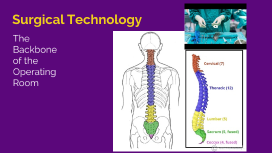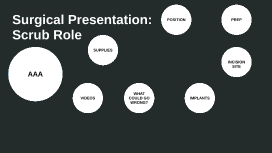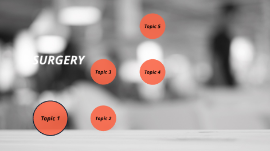Surgical presentation
Transcript: 3 T's Thromboemboilc Prophylaxis Observations Fluid balance HDU/ITU After assessment of the airway, you move onto assessment of breathing. What key piece of information has been missed / not mentioned at the moment? C-spine immobilisation What is the typical circulatory blood volume in a human? Case scenario URINALYSIS Which of the following signs change earliest in shock? HR rise and decrease in urine output RR rise BP decrease What is the simplest way of assessing airway patency? The "3 T's" Epigastric / RUQ Pain Initial Management Specific bloods (eg Pancreatitis) Radiology - USS / CT / MRCP Endoscopy - OGD / ERCP / Flexi sig Pancreatitis leading to definative Dx TRAUMA On completion of your primary survey, name three further things you would do for this patient Case continued… In what situations of head injury would you consider a CT head? LIF PAIN (if unwell) Initial treatment Monitoring Further Inx RIF PAIN BUGIE ECG Causes Fresh Haemorrhoids Angiodysplasia Left colonic tumours Mixed (with stools) Malaena GAS Team Hepworth strongly advise you book onto an upcoming ATLS course. Even if you will not be a surgeon, trauma is vital for anaesthetists, emergency doctors, and in fact for any doctor, given it is the 3rd leading cause of death world wide For available course dates, please see RCS website THANK YOU Causes PUD/GORD Gallstone disease Pancreatitis Liver disease / Hepatitis Myocardial infarction Basal pneumonia Anatomical causes Bowel 1) Appendicitis 2) Colitis 3) Caecal tumours (old) / Mesenteric adenitis (young) Gynaecological 1) Ectopic pregnancy 2) Ovarian cyst 3) PID Urological 1) Pyelonephritis / UTI 2) Ureteric colic 3) Renal colic Management of PR Bleeding In grade 1 shock, ie upto 15% of blood volume loss (ie 750mls) which of the following signs would change? RR HR Urine output BP Further investigations Circulation Give 5 key life threatening A and B problems to pick up on primary survey Airway obstruction Flail chest and pulmonary contusion Tension pnemothorax Open pneumothorax Massive haemothroax Examination GCS does not return to 15 within 2 hours Focal neurological signs Open depressed scull # Basal scull # CSF rhinorrhoea Battle’s sign (bruising behind the ears Blood from ears Periorbital bruising After assessment of the airway, you move onto assessment of breathing. What key piece of information has been missed / not mentioned at the moment? The paramedics bring him into resus as a trauma call. His GCS is 15 ad he has blood on his face. You are holding the on-call SHO bleep. Vital RR O2 Saturations General Cyanosis Resp distress / Accessory muscles Neck Tracheal deviation Distended neck veins Chest Inspection Chest bruising / deformity Unequal chest expansion Chest Palpation Surgical emphysema Tenderness Chest Percussion Hyperresonance (eg pneumothorax) / dullness Chest Auscultation Decreased air entry (eg pneumothorax) BLOODS Give 5 key life threatening A and B problems to pick up on primary survey The paramedics bring in a 60 year old male who fell from the loft onto the first floor landing, and then down a flight of stairs to the ground floor into a glass cabinet, lacerating his forehead. There was a 10 minute period of LOC. The paramedics bring bring him into resus as a trauma call. His GCS is 15 and he has blood on his face. You are holding the on-call SHO bleep. 3 T's IMAGING To ensure all FY1s are equipped with the knowledge for progression to FY2. To be able to give advice on common surgical presentations when asked for a specialty opinion Be able to make good quality referrals to surgical teams as non-surgeons A Review of GI Surgical Emergencies Dr M. Rahman ARNG Mr Daniel Boctor Leg ENd Dr Samantha Low HyP Er Mr Ibnauf Suliman Don Treat the symptoms BUGIE What is the simplest way of assessing airway patency? Is the patient talking? After conducting your primary survey, your findings are as follwed: A. The pt is talking B. RR=16, O2 sats=96% OA, equal chest expansion, resonance and good air entry bilaterally C. Normal assessment D. GCS=15. Pupils equal and reactive E. Abdomen soft, non-tender. No pelvic / long bone injury The paramedics bring in a 60 year old male who fell from his loft on to the first floor landing, and then down a flight of steps to the ground floor into a glass cabinet, lacerating his forehead. There was LOC for a period of ten mins. If the pt is not verbalising, what signs should be looked for that may indicate airway compromise / obstruction? 1) Snoring / gurgling sounds 2) Stridor 3) Facial / neck injuries On completion of your primary survey, name three further things you would do for this patient 1. CT Head and C-spine (due to mechanism of injury) 2. Take an AMPLE hx A allergies Medications PMHx and Pregnancy Last meal (when) E events (ie the mechanism of injury) 3. Perform a secondary survey (ie. head to toe examination) 1 in 3 people will have had PR bleeding BUGIE 3 “T”s Monitoring Catheter / Fluid balance Consider HDU Further investigations Bloods

















